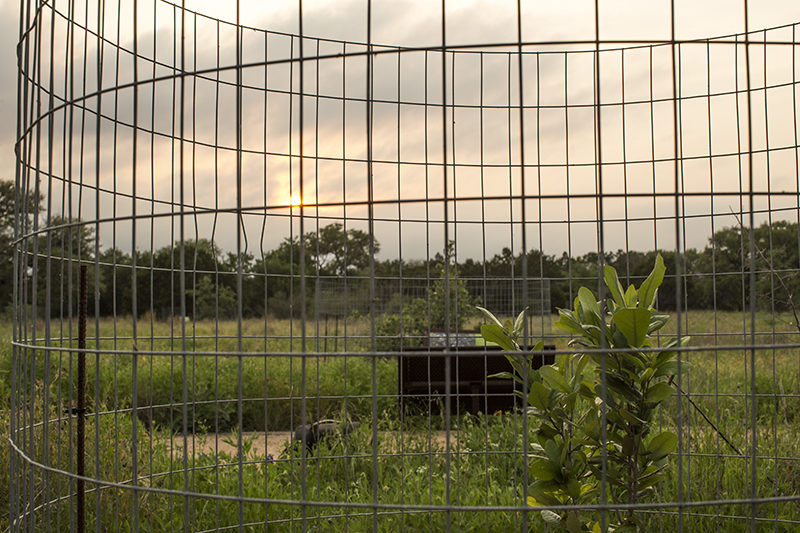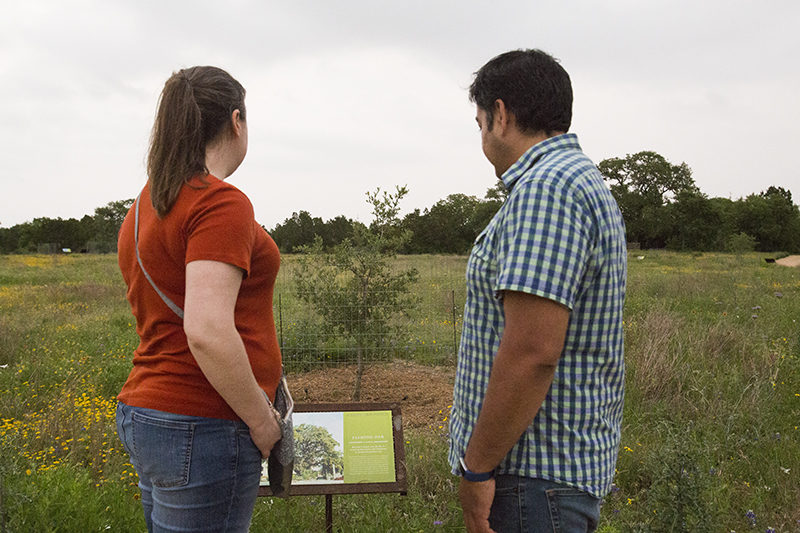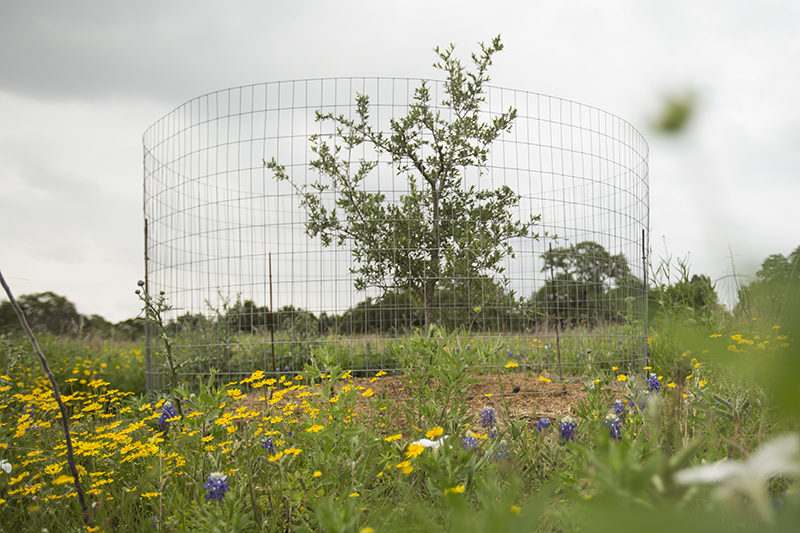Offspring of Famous Texas Trees Find Homes in Living Museums
By Shepard Price
Reporting Texas

A couple walks along the trail at UT-Austin’s Lady Bird Johnson Wildflower Center in Southeast Austin. Cristina Pop/Reporting Texas
Inside the Mollie Steves Zachary Texas Arboretum at the Lady Bird Johnson Wildflower Center in Southwest Austin, past the Texas kidneywood and Mexican oregano, is the Hall of Texas Heroes exhibit. Twenty-eight live oak saplings, surrounded by thriving trunks, wait to tell their stories.
The exhibit, which opened in 2015 with the planting of the first oaks, is made up of saplings collected from the acorns of famous trees from Texas history. The trees are part of a living museum, preserving diverse and dark aspects of the state’s past. One is the Cart War Oak, from which Anglo “troublemakers” hanged in 1857 after robbing and murdering Mexican teamsters; another is the Sieders Oak, which stood over the log cabin that pioneer Gideon White built near Shoal Creek in 1839 and under which he would die in a shootout with Native Americans in 1842.
In Texas, living museums like the one at the Wildflower Center continue to spring up. Two others are run by Harris County and at the Texas A&M Forest Service. Trees have been shared between the three museums, said Philipp Schulze, manager of the Arboretum at the Wildflower Center, which is a part of the University of Texas at Austin.

The sun sets on the oak tree saplings at the Lady Bird Johnson Wildflower Center in southeast Austin. The center covers 282 acres full of wildlife, trees, plants and research. Cristina Pop/Reporting Texas
The idea sprang from a project created by the Texas A&M Forest Service called the Famous Trees of Texas, an online compilation of historic trees and their stories. Another organization with a similar purpose is the Texas Historic Tree Coalition.
“We find culture in a museum,” said Erika Bsumek, history professor at UT-Austin. “What if we shift our perspective and learn about our natural environment as part of our history, especially now when the environment is changing quickly?”
The exhibit has taken on a new significance as climate change continues to influence the news, Bsumek said. As trees turn carbon dioxide into oxygen, they can help battle dangerous greenhouse gases.
“Trees have always migrated based on climate, but now with climate change, we have Northern arborists who are importing native trees,” Bsumek said. “That tells us a lot about how we’re dealing with our current moment and how we’re thinking about the future. Replanting trees shows that they matter.”
The acorns took five years to collect and two years to plant. Each sapling took two to four years to grow in the nursery before Wildflower Center staff and volunteers put them back into the fresh air. The surrounding area is made up of other trees, examples of what the Arboretum hopes these trees can become.

An Austin couple reflects in front of an oak sapling at the Lady Bird Johnson Wildflower Center in Southeast Austin. Cristina Pop/Reporting Texas
“I expect them to outlive myself,” Schulze said. “They could live hundreds of years.”
Live oaks were used for multiple reasons, including their long life spans. Trees that saw the 1800s are still around; at the far side of the circular exhibit is one of the most famous trees in Texas, the Goose Island Oak, which is at least 1,000 years old. The tree was around to see Spanish and French explorers come and go, as well as the town of Lamar, which was destroyed by Union soldiers during the Civil War.
Each tree tells a story of a different event. One is the Old Evergreen Tree, around which the town of Evergreen, Texas, sprouted and then disappeared after the San Antonio and Aransas Pass Railroad by-passed Evergreen in 1890. There’s the Runaway Scrape Oak, where Sam Houston and a force of 400 Texan rebels camped on their first night during their retreat from Gonzales.
Perhaps no tree in the exhibit is as central to Native American history in Texas as the Indian Marker Oak. Comanche people tied down its branches to to point to safety, shelter, water and food. Schulze said the Arboretum has plans to tie down the sapling’s branches when it’s more mature to better match the parent tree.
The Comanche tribe has issued six proclamations, the most recent in June 2017, verifying the importance of the marker trees in Texas to Comanche culture.
“For the tribe, it was very important,” said Theodore Vilicana, technician at the Comanche Nation Historic Preservation center. “They left those trees for individuals. That’s how they survived in the wilderness.”

In 1982, the center was established by Lady Bird Johnson, a former First Lady, to preserve the the nation’s wildflowers. Cristina Pop/Reporting Texas
The live oak was also chosen because of its value in real time. “They’re widespread,” Schulze said, “and the shelter underneath the canopy of a live oak is a natural shelter from the summer sun and from the weather.”
Many of the events that took place beneath the live oaks represented in the Hall of Heroes were because of that natural shelter. The oaks were used to shelter land auctions in Kyle and in Austin. They were used for some of the first churches in the area. The Panna Maria oaks sheltered the first permanent Polish community in the southwest, and the church for the community was built around those trees.
These trees have also been used for rituals: Native American nuptials took place under the Matrimonial Oak, and it is said that if you pass under the Century Tree in College Station with your partner, you’ll be bound to marry.
“The fact they have this exhibit that is trying to convey that trees matter on all these levels, that seems really important and significant,” Bsumek said.